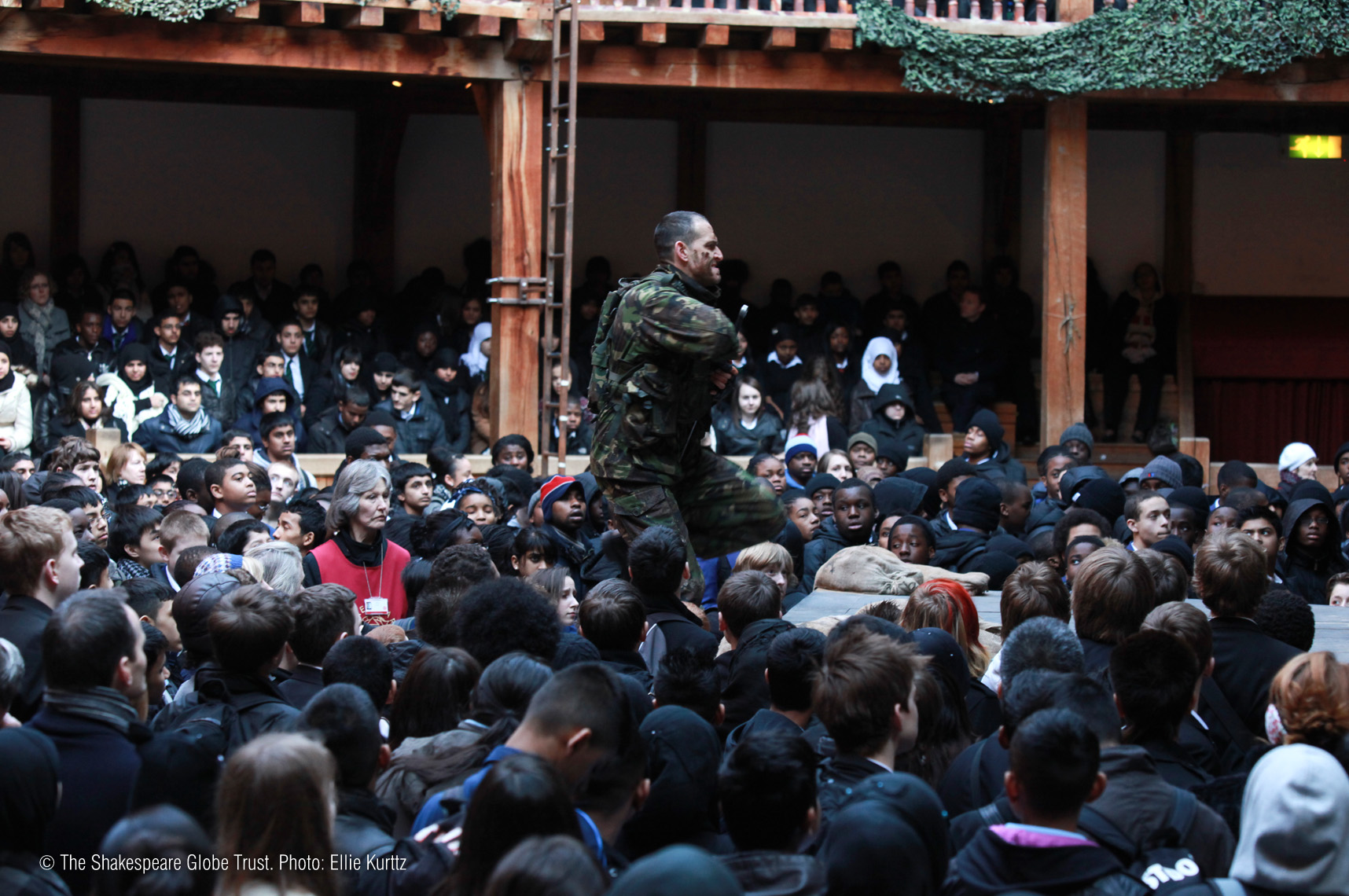In these lessons, students will examine the key characters in Macbeth and their dramatic functions. Tasks include: an exploration of the 'tragic hero' archetype; examining three perspectives on how and why Macbeth changes throughout the play, informing their own ideas; and a list of practice exam questions with an emphasis on characterisation.
In order to benefit fully from these lesson plans, we recommend you use them in the following order:
- Text in Performance
- Language
- Characters
- Themes
- Contexts
If you would like to teach the play in greater detail, use these advanced KS4/5 Lesson Plans. If students are new to the play, we suggest you start with the introductory KS3 Lesson Plans.
These lesson plans are available in the Downloads section at the bottom of this page. To download resources, you must be logged in. Sign up for free to access this and other exclusive features. Activities mentioned in these resources are available in a separate downloadable 'Student Booklet', also at the bottom of this page. The 'Teachers' Guide' download explains how best to use Teach Shakespeare and also contains a bibliography and appendices referencing the resources used throughout.
Key Questions for Students:
Can I investigate how Macbeth’s character changes and develops over the course of the play?
Can I use my study skills to track and record these changes?
Key words: character, compare, contrast, development, essay, Macbeth
Prologue: Opening Discussion
Explain to students that over the course of the next few lessons, they will be investigating the character of Macbeth in even greater detail. They will be researching, planning and drafting an essay that focuses on one particular extract, but they will be expected to make links to other parts of the play too, so they will need to consider how he develops and changes in the play as a whole.
Enter the Players: Group Tasks
1) 'Walk of fame, walk of shame'
This is another activity from Fiona Banks Creative Shakespeare. Students locate and write out on to pieces of paper quotations about Macbeth that describe him in a positive or in a negative light. The students arrange themselves in two rows facing each other with a wide space in between and each is given a different positive quotation. The students say their quotations as one student walks down between the rows listening to all the positive remarks. All students take it in turns to do this. Repeat with negative remarks. Afterwards discuss how it felt to hear those comments and why Macbeth changes to the extent that he does.

2) Before and after
Conduct a comparison of Macbeth in Act 1 (Scenes 2, 3 and 4) with Macbeth in Act 5 (Scenes 2, 3 and 5). List all the different ways in which he has changed and rank them. Now hold a class discussion about what have been the greatest changes in Macbeth. Students could write up this discussion in a series of points, including plenty of compare and contrast phrases like ‘whereas’, ‘however’ and ‘on the other hand’. Finally, consider how the change should be shown on stage and look at scenes from the beginning and end of one or more versions to see how this has been achieved.
3) Zooming in and out
One of the biggest challenges with studying a substantial text is being able to ‘zoom in’ on important details in the text without forgetting to ‘zoom out’ and view that detail in context. A range of techniques can be used to support students so that they can:
- make links and draw comparisons
- comment on patterns and motifs
- track characters and themes
These techniques could include: systematic annotation of texts/revision notes, graphic organisers, classroom display, creative use of plot synopses and logs, blogging about the text and ‘tagging’ key characters, themes, motifs, etc. It could be useful to share with students a range of approaches – even if the examples come from work on other texts – to help them develop their study skills in a way that suits their learning style. Students could also demonstrate and record their own methods for investigating a character or theme.
Exeunt: Closing Questions for Students
How and why does Macbeth change over the course of the play?
What kinds of notes should I make to keep track of these changes in my preparation for an essay about Macbeth?
Suggested plenary activity…
In secret, students should pick a moment in the play that is an important turning point for Macbeth. They should write it down and explain why they have chosen it on a piece of paper. Collect the papers and feedback to the class at the beginning of a subsequent session.
Asides: Further Resources
- Two brief extracts from Act 5 of the 2010 Globe production of Macbeth starring James Garnon can be viewed via these links:
Epilogue: Teacher's Note
This page and the following two pages comprise an active investigation into Macbeth as a tragic hero, culminating in an essay which looks at one extract in detail and places that in the context of the play as a whole.
Key Questions for Students:
Can I explain what motivates Macbeth’s decisions in the play?
Can I research different theories to explain Macbeth’s downfall?
Key words: character, criticism, downfall, fatal flaw, hero, Macbeth, protagonist, tragedy, tragic
Prologue: Enter the Players
Display the following snippet from the helpful notes at the back of Globe Education’s Macbeth textbook:
Hero/tragic hero: Macbeth is first presented as a hero: 1.2; he becomes a tragic hero (because of his actions or what is done to him); e.g. ambition 1.3; 2.2; 3.3; the Witches’ influence 4.1; 4.2 Macbeth realises he has been deceived 5.7.71-end]
Q1) What do you understand by the term ‘tragic hero’? Does this term accurately describe Macbeth in your opinion?
Q2) These notes list some of the factors in Macbeth’s downfall. Do you agree? Are there any factors you would add?
Q3) What makes this an effective example of note-taking?
Enter the Players: Group Tasks
1) An actor’s view
Students are going to hear/read three perspectives on how and why Macbeth changes in the play. Explain that they are going to read different viewpoints, so that they can see a range of ideas. Explain that if you can see the text from more than one point of view, you can see more than one meaning and this is a good thing!
The first is an extract from a Globe podcast with James Garnon who played Macbeth at the Globe in 2010:
‘It can be understood on many different levels and that’s why these things can be done over and over and over again. So, for example, you know the idea that Macbeth is a villain or is evil – it’s a lot more ambiguous than that…He is not as black and white as people would like to imagine he is…So I think Macbeth is to an extent an everyman…My understanding of medieval morality plays is that often one of the main points of them is that you shouldn’t seek security or safety outside of God. You should trust to God and not seek to make you life comfortable through any other means. The mistake that Macbeth makes having committed the sin is then to try and make himself secure and safe outside of a religious context. He goes to the witches. They’re the only people he goes to for further advice, and all the further crimes that he commits are done in an attempt to shore his position up.’
2) A director’s view
The second perspective is from the director of that production, Bill Buckhurst.
‘I choose it [Act 1 Scene 5] as my pivotal scene for the reason that you say, that his mind changes. It’s fascinating to see that first scene he has with Lady Macbeth. He doesn’t mention doing the deed at all. He just says,
Macb: Duncan comes here to-night
Lady M: And when goes hence?
Macb: To-morrow, as he purposes.
Lady M: O! never
Shall sun that morrow see!
says Lady Macbeth. And then she says, 'Your face, my Thane, is as a book, where men/May read strange matters'.
And it’s almost like they speak in code to each other, or at least Lady Macbeth interprets in the way he’s looking the way that he’s feeling. Now we know from the scene before that he’s had a horrible image of doing a terrible thing. After all, how else could he become king?...We know from that first scene with the witches Macbeth has had a thought which he doesn’t want to have. He’s an honourable guy, he’s a good soldier, and he believes in his king. And so to take that big leap of faith, OK right, we’re going to do it…once he’s had that thought and he’s prepared to go along with it, that means that the story can really race ahead. So that’s why I chose that as a pivotal scene.’

3) Some critics’ views
The third viewpoint is taken from a critical essay from the Globe’s website and the fourth from the famous Shakespearean critic A.C. Bradley.
'Because Macbeth was a real Scottish king, Shakespeare could have written a history play. Instead, the playwright changed the history books to make his play more dramatic and exciting. The real Macbeth was a successful, popular king whose reign lasted many years. Shakespeare’s Macbeth, though, meets witches, sees ghosts and convinces himself that he has to murder children to keep his throne. But the most important thing Shakespeare adds is the thought process of Macbeth and Lady Macbeth. ‘Stars, hide your fires!’ says Macbeth, ‘Let not light see my black and deep desires’ (1.4.51-2). We in the audience, though, do see those desires. We see him change his mind – ‘We will proceed no further in this business’ – and so does Lady Macbeth, who has to change it back: ‘Art thou afeard | To be the same in thine own act and valour, | As thou art in desire?’ (1.7.31; 39-41). We know the desires which Lady Macbeth is talking about, for we have seen them just as she has. The difference is that we know when they are ‘acted’ upon, tragedy will surely follow.'
The prophecies of the Witches are presented simply as dangerous circumstances with which Macbeth has to deal….[N]o innocent man would have started, as he did, with a start of fear at the mere prophecy of a crown, or have conceived thereupon immediately the thought of murder…In either case not only was he free to accept or resist the temptation, but the temptation was already within him… For all that appears, the natural death of an old man might have fulfilled the prophecy any day. In any case, the idea of fulfilling it by murder was entirely his own.
For each of the three viewpoints, students should ask about how it helps them to think about how and why Macbeth changes in the play. What motivates him? To what extent is he himself flawed? What other factors play a part in his downfall or is he solely to blame?
Exeunt: Closing Questions for Students
What motivates Macbeth at different points in the play?
What are the reasons for his downfall?
To what extent does Shakespeare give Macbeth a fatal flaw?
Suggested plenary activity…
The Globe actress Yolanda Vasquez shares a list of questions she asks when she is rehearsing a play. Students could answer these questions about Macbeth at the beginning of Act 1 and repeat this for Macbeth at a later point in the play that they can choose. They should write in modern English in the first person.
1) Who am I?
What kind of person is this character? What is the character’s background, influences, education, experiences, likes and dislikes, relationships? What are their inner and outer characteristics?
2) Where am I?
What kind of place is the character in? Is it familiar or unfamiliar? What does it mean to the character, if anything? How does the character feel about their surroundings?
3) When is it?
What is the time of year, day, or season? Why is the scene set at that moment? What’s happened before? Where is the character going to afterwards?
4) What do I want?
This is the character’s primary need, their desire. Actors often refer to this as a character’s ‘objective’.
5) Why do I want it?
The character must have a good reason for wanting it. It justifies their objective.
6) How will I get it?
What does the character need to do to accomplish his/her objective? (E.g. beg, plead, tease, threaten, etc.) What tactics does s/he use? These can be both verbal and physical?
7) What must I overcome?
This is the resistance. It’s what’s stopping the character from obtaining his/her objective. This might be an inner obstacle (coming from the character’s own characteristics or physical or mental state of being) or an outer obstacle (coming from the character’s situation or relationship). This might also be affected by the objectives of other characters.”
Aside: Further Resource
- The full essay about tragedy can be found here: 2011.playingshakespeare.org/themes-and-issues/tragedy.
Epilogue: Teacher's Note
This is the second of three consecutive lesson plans that together form an active investigation into Macbeth as a tragic hero culminating in an essay which looks at one extract in detail and places that in the context of the play as a whole.
Key Questions for Students:
Can I describe what I understand by the terms ‘tragedy’ and ‘tragic hero’?
Can I apply these terms to help me gain a deeper understanding of the plot of Macbeth and of Shakespeare’s characterisation of Macbeth?
Key words: characterisation, Macbeth, plot, structure, tragedy, tragic hero
Prologue: Opening Discussion
In the previous learning sequence, the term ‘tragic hero’ was used. Ask students to return to their notes about this from yesterday’s lesson. What is their understanding of the ‘tragic hero’ and ‘tragedy’? Create a brainstorm of ideas on the board.
Enter the Players: Group Tasks
1) Shakespeare’s tragedies
Divide the class into four groups. Assign one of Shakespeare’s most famous tragedies other than Macbeth to each group (e.g. Romeo and Juliet, King Lear, Hamlet and Othello). Students should fill in a grid to establish first of all what they already know about that play, to work out some questions to guide their research, and then to carry out that research recording their answers. Students could have access to a prepared book box or to online materials, or they could visit the library to carry out this task.

Take feedback from each group. This should include a summary of the play for the rest of the class, e.g. in a series of tableaux images. Discuss what the storylines of these plays and their central heroes have in common.
2) The Tragedy of Macbeth
Does Macbeth fit or break the mould of the ‘tragic hero’? Why isn’t Macbeth classed as a history play? How do you think Shakespeare intended to affect his audience with the story of Macbeth’s rise to power and downfall?
Students could discuss in small groups: ‘What makes Macbeth a tragedy?’
Within their discussions, they should consider:
- the play’s plot and structure
- Shakespeare’s characterisation of Macbeth
Students should draw on their textual knowledge and their research into the genre of tragedy in order to answer this question as fully as possible. Students could distil their ideas into their three best and most compelling points and feedback to the class.

3) Essay task in exam conditions
This writing task is designed to be undertaken in exam conditions. Before they begin, students should be encouraged to:
- identify the key words in the question
- think of suitable examples and find evidence from the passage and from the play as a whole
- write a plan of their ideas and how they will structure their answer
Exam style question:
Read the section of Act 3 Scene 1 that begins with Macbeth saying ‘To be thus is nothing, but to be safely thus:’ (line 47) and ends with ‘Who’s there?’ (line 71). How does Shakespeare present Macbeth as a tragic figure in this passage, and in the play as a whole?
Exeunt: Closing Questions for Students
What do I understand by ‘tragedy’ and ‘tragic hero’?
What makes Macbeth a tragedy?
How does Macbeth compare with Shakespeare’s other famous tragic heroes?
Suggested plenary activity…
It is likely that class time will be used for writing in timed conditions. but all students could be reminded in the last few minutes to review the success criteria and to proofread their work carefully.
Asides: Further Resources
- Suitable books for the ‘Shakespeare’s tragedies’ activity could include The Shakespeare Book published by Dorling Kindersley, Andrew Dickson’s The Rough Guide to Shakespeare and Leon Garfield’s Shakespeare Stories.
- Students could also, perhaps as an extension activity, revise tragedy in a wider sense. For example, comparing Aristotle’s ideas about tragedy as expressed in his Poetics with Shakespeare’s great tragedies, or comparing the downfall of Macbeth with the downfall of Willy Loman in Death of a Salesman.
Epilogue: Teacher's Note
This is the third of three pages that investigate Macbeth as a tragic hero, culminating in an essay that looks at one extract in detail and places that in the context of the play as a whole. Further questions about character and motivation, along with quizzes and revision tips, can be found on the next page.
Key Questions for Students:
Can I make useful notes about characters from the text for revision purposes?
Can I check that my notes contain textual evidence and references that I can cite in my essays?
Key words: characters, cite, development, evidence, notes, revision, textual evidence
Prologue: Opening Discussion
Ask students to write on a sticky note some things that make notes useful and build a spider diagram using the sticky notes on the board. Points might include: legibility; organisation; detail; coverage; fit for purpose (awareness assessment criteria etc.); memorable; matched to individual learning style (e.g. use of colour-coding, graphic organisers or voice recordings of notes).
Enter the Players: Group Tasks
1) Character passport
You should model making notes about a character on a large flip chart size piece of paper, creating a passport-style poster with the following features:
- name of character
- headshot of actor who played that part on page
- any textual information about that character’s age/appearance/birthplace/dwelling
- bullet points about that character’s title/role/relationship to other characters
- adjectives to describe that character
- “passport stamps” – key moments in that character’s ‘journey’ through the text
2) Revision Diaries
Students should record this character passport in the Student Booklet. This can be repeated for other characters on additional copies of the passport sheet and inserted into the Student Booklet.

3) Task bank: character and motivation
The following tasks can be used in the modelling of planning and drafting written tasks, as well as for students’ more independently produced work for assessment:
- Write a comparative character study about the qualities and flaws of the play’s three kings: Duncan, Macbeth and Malcolm.
- How does Lady Macbeth’s character change throughout the play and how does Shakespeare show this?
- What is the dramatic function in Macbeth of the character of Macduff?
Exeunt: Closing Questions for Students
What makes revision notes useful and memorable?
What do I know about my own preferred learning style that can help me revise as efficiently as possible?
Suggested plenary activity…
Share and compare pieces of evidence that students have selected to support key points. Ask follow-up questions to support students in their language analysis skills.
Asides: Further Resources
- For a particularly collaborative approach to revision, students could work in groups on a particular character and photocopies could be made of their finished poster for distribution to the whole class.
- Ensure students know how to record the part of the play from which each quotation comes (i.e. act, scene and line references), and the importance of keeping quotations short (especially if students are preparing for an exam on the text).
Epilogue: Teacher's Note
For more detailed guidance on planning, drafting and language analysis, see Language and the linked materials in the Student Booklet.
